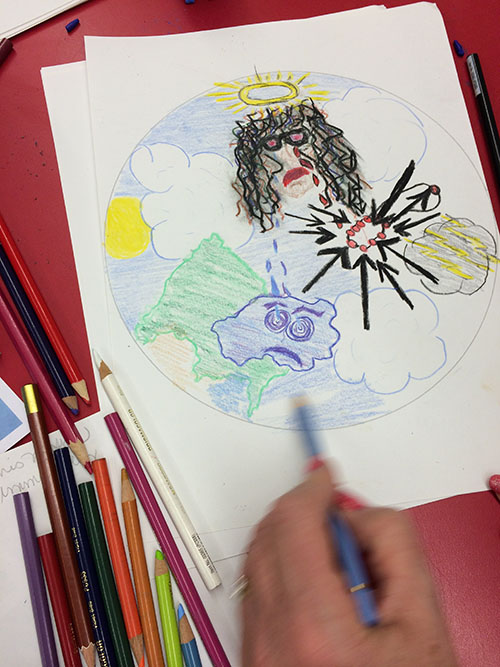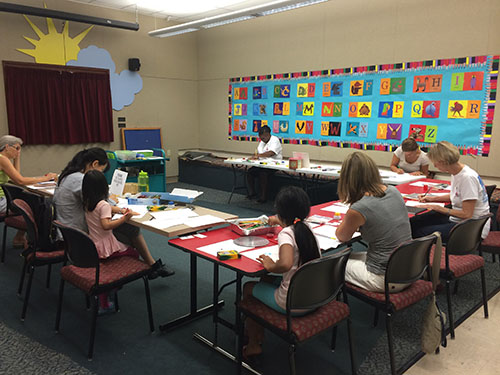Laura De La Maza and Dianne Tennyson Vincent reached out to the Gibbes Museum after the tragic shootings at the Mother Emanuel AME church. They wanted to do something to help the community heal and were in the beginning stages of formulating a plan so we suggested bringing in our colleagues from the Halsey Institute of Contemporary Art and Redux Studios to help brainstorm. Dianne had led an Art of Healing workshop for the Gibbes in 2012, in which students created mandalas, and following the tragedy, she spoke to us about offering this concept to the community as a way to heal. Laura has worked as an art teacher for years and uses mandalas in the classroom. In the last few weeks these women have worked tirelessly to create a series of free workshops to be offered at the Charleston County Public Library on Calhoun Street through the end of September. They were kind enough to answer a few questions about Hearts Mends Hearts.
How did you become involved with art as a healing endeavor?
Dianne: I became interested in art as a way to heal personally while going through a divorce. Intensely personal, I found it easier and more natural to draw what I experienced on an emotional level than to write or talk about it. I began painting again, which I had given up while married. I discovered the images that I was drawn to reflected what I was going through at the time emotionally: landscapes of paths, roads, and desert scenes. While trying to discover my next path, I stumbled into the field of art therapy and eventually went back to graduate school and became a registered art therapist.
Laura: I realized the healing power of art after going through Hurricane Hugo that destroyed my home. Creating mandalas in the evenings by candlelight as there was no electric power, helped calm me as I dealt with loss, natural devastation, and shock. I also began creating mandalas with students as we were all experiencing losses connected to this natural disaster. The very act of producing images or designs within the circle helped us heal from the devastation in our lives. We came together as a group and embraced another school that had been totally lost due to the hurricane. As we worked side by side for several months that school year, we created human healing circles as well as the visual metaphor called a mandala.

Can you tell me more about these healing circles?
Dianne: Healing circles are mandalas. The word mandala comes from Sanskrit, the ancient language of India. A mandala is a universal symbol or archetype used in all religions and cultures that means “healing circle,” “completeness” or “sacred circle.” Circles suggest unity, wholeness, completion, and eternity. Circles are universally associated with meditation, healing, and prayer.
Psychoanalyst Carl Jung used mandalas with his clients and himself. He saw the mandala as “a representation of the unconscious self,” and “expressing the idea of a safe refuge, inner reconciliation and wholeness.” Jung called mandalas “vessels” into which we project our psyche. Experienced consciously, this message from the unconscious is a means for restoration and growth.

What do you hope these workshops will do for the community?
Dianne: As a witness to the life changing effects of art therapy for over fourteen years as an art therapist, including two trips both to Bosnia and Haiti through the ArtReach Foundation and here at home while in private practice, I am still amazed of the power of making art. Art is a creative, non-threatening way to deal with trauma. Children are less articulate verbally, and are often afraid to express themselves, so the metaphors of art are a powerful, direct means to deal with the intense emotions of horror, loss, sadness, anger, and isolation. Increased self-awareness, decreased anxiety, energy and empowerment increases self-worth and confidence and helps reconcile emotional conflict. Any age can and will benefit and each participant, one person at a time, will ultimately help heal our community.
Laura: I hope these workshops provide a platform for healing. Our first workshop was on Sunday, July 26th and we had a nice turnout with 16 participants of all ages and races. The attendees were engaged and all shared what they had created for display, and most engaged in the processing afterwards. At both sessions this week, attendees that knew one of the slain members at Emanuel AME came to the library to take part in the workshop. On Sunday, a mother and daughter came, and the young girl had visited the West Ashley branch of the library often, having made the acquaintance of Cynthia Hurd. This 4-year-old asked her mother to share what her drawing was about. It was very moving to hear the mom recount their visits to the library, and their conversations with Miss Cynthia, and how she had encouraged the little girl to love books and to visit the library.
Free Hearts Mend Hearts drop-in sessions are offered at CCPL Main Library on Calhoun Street through the end of September. They are designed to help individuals process their feelings and express emotions in a safe environment.
Sundays from 2-4:30pm
Tuesdays from 5:30-7pm
Thursdays from 5:30-7pm
For more information visit their website at HeartsMendHearts.com
Dianne Tennyson Vincent, MAT, ATR, Registered Art Therapist
Dianne has been creating art since she began painting at age 12. Graduating in Nursing from the Southern Adventist University when she was only 19, she quickly realized life as an OR nurse was not for her, so she went to the College of Charleston for her bachelors in Studio Art and then to the University of South Caroline for her Masters in Art Education. Odd, though fortuitous events landed her a job as Art Therapist at Fenwick Hall Hospital, (a psychiatric-substance abuse hospital.) and from there she went on to complete 30 graduate and two thousand clinical hours to earn her requirements to be a registered art therapist with the American Art Therapy Association.
She has taught art privately since she was 19, and as an elementary, middle and high school art instructor for the Charleston County School District for 14 years. She now runs her Art Connects Art School with her husband while maintaining her private art therapy practice in Mount Pleasant. She promotes art therapy locally through an ongoing series of presentations geared for both professional mental health care givers and the general public, and has done numerous mandala workshops to familiarize the public with the healing power of the mandala.
Laura De La Maza, National Board Certified Teacher, Art
Expressing art through teaching, art making, and creating visual stories defines the work of Laura De La Maza. Influenced by the Caribbean color and landscape where she grew up, De La Maza expresses life’s journey through mandalas, mixed media, and symbol. The spiritual connection expressed in her images defines her art teaching and personal work. De La Maza teaches high school art in the Lowcountry.
Published July 29, 2015

